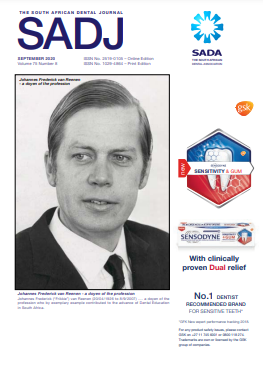Clinical management of Sialadenitis
DOI:
https://doi.org/10.17159/2519-0105/2020/v75no8a10575Keywords:
SialadenitisAbstract
Within the area of salivary gland pathology, obstructive sialadenitis is the most common inflammatory condition of the salivary glands.1
It has been well established in the literature that salivary calculi occur most commonly in the submandibular gland, whereas fewer cases are found in the parotid gland, while the sublingual gland and the minor salivary glands form no more than 2% of cases.2
The early treatment of sialadenitis is usually conservative and involves hydration, anti inflammatory medication in conjunction to antibiotics when a bacterial infection is suspected. However, when initial treatment fails, further intervention is needed.
The traditional external approach is sialadenectomy. However, with this exists the potential for injury to the lingual and facial nerves. Further complications including bleeding, infection and an unsightly scar are also found with this procedure.3,4
Sialendoscopy is a relatively new technique that only became available once optics had improved to the extent that fiber-optic endoscopes could be miniaturized to a diameter of 0.9 mm to 1.6 mm. This has ushered in a new era for the management of sialadenitis, particularly in cases where sialadenitis was caused by salivary duct obstruction.
It must be noted that in South Africa, there are currently no generally accepted guidelines on the management of sialadenitis secondary to salivary ductal obstruction as well as in the role of sialendoscopy within the treatment algorithm.
Downloads
References
Strychowsky JE, Sommer DD, Gupta MK, Cohen N, Nahlieli O. Sialendoscopy for the management of obstructive salivary gland disease: a systematic review and meta-analysis. Arch Otolaryngol Head Neck Surg. 138(6): 541-7.
lanovski I, Morton RP, Ahmad Z. Patient-perceived outcome after sialendoscopy using the Glasgow benefit inventory. Laryngoscope. 2014; 124(4): 869-74. doi:10.1002/lary.24343.
Kroll T, Finkensieper M, Sharma SJ, Guntinas-Lichius O, Wittekindt C. Short-term outcome and patient satisfaction after sialendoscopy. Eur Arch Otorhinolaryngol. 2013; 270(11): 2939-45.
Marchal F, Dulguerov P. Sialolithiasis management: the state of the art. Arch Otolaryngol Head Neck Surg. 2003; 129: 951-6.
Nahlieli O, Nakar LH, Nazarian Y, Turner MD. Sialoendoscopy: a new approach to salivary gland obstructive pathology. J Am Dent Assoc. 2006; 137(10): 1394-400.
Katz P. Endoscopy of the salivary glands. Ann Radiol (Paris) [cited 2018 Oct 6]. 1991; 34(1-2): 110-3. Available from: http://www.ncbi.nlm.nih.gov/pubmed/1897843.
Singh PP, Gupta V. Sialendoscopy: introduction, indications and technique. Indian J Otolaryngol Head Neck Surg. 2014; 66: 74-8.
Nahlieli O. Complications of sialendoscopy: personal experience, literature analysis, and suggestions. J Oral Maxillofac Surg. 2015; 73.
Downloads
Published
How to Cite
Issue
Section
License
Copyright (c) 2021 Nadir Kana, Zarreen Cassim, Shivesh Maharaj

This work is licensed under a Creative Commons Attribution-NonCommercial 4.0 International License.





.png)